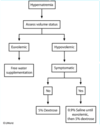Renal, Urinary Systems and Electrolytes III Flashcards
(64 cards)
What is the likely diagnosis in a young female with orthostatic hypotension, hyponatremia, and hypokalemia with high urine Na+ and K+?
Diuretic abuse
normally dehydrated patients with hyponatremia and hypokalemia will have reduced urine Na+/K+
What is the likely diagnosis in a young female with photosensitivity, headaches, thrombocytopenia, hematuria, and proteinuria?
SLE

What is the likely diagnosis in an adolescent with recurrent kidney stones and hexagonal crystals on urinalysis?
Cystinuria
due to defective transport of dibasic amino acids (cystine, lysine, arginine, and ornithine); stones are classically hard and radioopaque
What is the likely diagnosis in an afebrile elderly male with BPH who experiences agitation and lower abdominal tenderness 2 days after surgery?
Acute urinary retention
diagnosis is confirmed by bladder ultrasound; treatment is insertion of a Foley catheter
What is the likely diagnosis in an elderly diabetic with non-anion gap metabolic acidosis, hyperkalemia, and mild renal insufficiency?
Type 4 (hyperkalemic) renal tubular acidosis
most common in elderly patients with poorly controlled diabetes (damage to the juxtaglomerular apparatus results in hyporeninemic, hyperaldosteronism)
What is the likely diagnosis in an elderly patient taking a TCA that develops abdominal pain and suprapubic fullness?
Urinary retention
due to anticholinergic properties of TCAs, which prevents destrusor muscle contraction and urethral sphincter relaxation
What is the likely ingested agent in a patient who overdosed and presents with fever, tinnitus, and tachypnea?
Aspirin
causes mixed respiratory alkalosis and anion gap metabolic acidosis
What is the likely underlying cause of refractory hypokalemia in an alcoholic patient?
Hypomagnesemia
intracellular Mg2+ typically inhibits potassium secretion by renal outer medullary potassium (ROMK) channels
What is the likely underlying etiology of kidney disease with arteriosclerotic lesions of renal arterioles?
Hypertension
hypertension first manifests as nephrosclerosis and evolves to glomerulosclerosis
What is the likely underlying etiology of kidney disease with GBM thickening, mesangial expansion, and glomerular sclerosis?
Diabetic nephropathy
What is the long-term treatment for severe hypercalcemia (> 14mg/dL or symptomatic)?
bisphosphonates (e.g. zoledronic acid, pamidronate)
symptoms include weakness, GI distress, and neuropsychiatric symptoms

What is the most common cause of abnormal hemostasis in patients with chronic renal failure?
Platelet dysfunction
What is the most common cause of death in dialysis and renal transplant patients?
Cardiovascular disease
accounts for approximately 50% of all deaths in dialysis patients
What is the most common cause of glomerulonephritis in adults?
IgA nephropathy
What is the most common extrarenal manifestation of autosomal dominant PKD?
Hepatic cysts
other extra-renal complications include berry aneurysms, valvular heart disease, colonic diverticula, and abdominal wall/inguinal hernia
What is the most common form of drug-induced chronic renal failure?
Analgesic nephropathy
suggested by elevated creatinine with urinalysis showing hematuria or sterile pyuria

What is the most common malignancy associated with painless hematuria in adults?
Bladder tumors
especially patients age > 35 with a smoking history
What is the most common reason for higher incidence of UTIs in females than in males?
Shorter urethral length in females
other predisposing factors include sexual intercourse, recent antibiotic use, spermicidal contraceptives, and close proximity of the urethra to the anus
What is the most common type of kidney stone?
Calcium oxalate
What is the most important intervention for preventing contrast-induced nephropathy?
Adequate IV hydration
with isotonic bicarbonate or normal saline; acetylcysteine administration may reduce risk as well
What is the next step in evaluation of acute kidney injury in an elderly patient with BPH who presents with rising creatinine and urinary urgency without hematuria, weight loss, or elevated PSA?
Renal ultrasound
helps assess for hydronephrosis and other causes of obstruction
What is the next step in management for a patient with acute renal failure and oliguria with evidence of significant urine retention?
Bladder catheterization
may also place a catheter if the bladder scan is inconclusive

What is the recommended management for a patient with uremic encephalopathy?
Hemodialysis

What is the recommended management for an asymptomatic simple renal cyst?
Reassurance (no follow-up required)





























